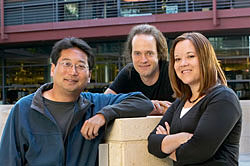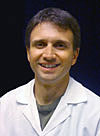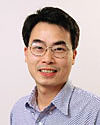September 23, 2008 - By Rosanne Spector
Two medical school scientists who've sussed out ways to see what's usually hidden are winners of this year's NIH Director's Pioneer Awards - the National Institutes of Health's most prestigious award for creative thinkers.

James Chen, Zev Bryant and Shelli Kesler are three of Stanford's five new Pioneer and Innovator grantees.
Secrets held within a developing embryo and a living being's brain, respectively, are the objects of the research of award winners, James Chen, PhD, and Ricardo Dolmetsch, PhD.
The NIH announced this year's 16 Pioneer Awards on Sept. 22 with the winners of its prize for up-and-coming original thinkers, the New Innovator Awards. Three of this year's 31 innovator prizes go to Stanford faculty: Zev Bryant, PhD; Shelli Kesler, PhD, and Joseph Wu, MD, PhD.
Now in its fifth year, the Pioneer Award provides each investigator with $2.5 million in direct costs over five years. The innovator program, launched last year, provides $1.5 million in direct costs over the same time period. Stanford has reaped a major share of the Pioneer Awards, with its faculty winning 11 of the total 63. Ten of the winners are at the medical school. Both awards aim to encourage unconventional research efforts that might carry a greater-than-usual risk of not succeeding.
'What makes Stanford so unique and special is the extraordinary talent of our faculty: They are intelligent, creative, innovative, and visionary,' said Philip Pizzo, MD, dean of the School of Medicine. 'Such a remarkable group of scientists helps create an environment that is exciting, and the insights that result for science and medicine are breathtaking.'
Pioneer Award winner Chen, assistant professor of chemical and systems biology, will use his prize to study how embryos develop at the molecular level. He will study zebrafish, a fruitful research subject for vertebrate biologists, in part because its embryos and larvae are transparent and develop externally. 'You can directly observe their development and physiology with single-cell resolution,' he said.
Chen's lab has previously invented methods that scientists can use to disrupt the action of specific zebrafish genes. Inactivating genes in a tissue-specific manner is routine in such model organisms as fruit flies and mice, but not in zebrafish, a relative newcomer to biomedical research. To address this limitation, Chen's lab developed technologies that allow precise control of gene function in the fish, including a method that uses a focused beam of light to switch genes off in specific tissues.
With the support of the award, Chen plans to branch off in a new but related direction, developing technologies to make gene and protein activity visible in living organisms. 'This would allow us to intimately link gene function with the cellular and morphological changes that occur during and after vertebrate development,' he said.

Ricardo Dolmetsch
Dolmetsch, assistant professor of neurobiology, will use the Pioneer Award to continue his work on the biological basis of autism. His approach allows him to bypass one of the major challenges of researching psychological problems: How to study the brain cells of affected people without taking a biopsy - a complex and risky surgery - from their brain. 'For 50, 60 years, we've been trying to figure out what's been wrong. The reason we've been stymied is you just don't have access to the tissues,' he said.
His solution? A 'grow-it-yourself' approach. His lab is one of a small number to report success at transforming skin cells into neurons. With his new award, he plans to harvest autistic people's skin cells and transform them into stem cells, which in turn he will differentiate into neurons. The next step is to characterize them. He'll use automated assays he's developed to see how the neurons form connections with other neurons and which genes they use. Ultimately he aims to set up a facility to create neurons for tens of thousands of autistic people to test treatments and sort out the different types of autism.
New Innovators:
New Innovator Award winner Bryant, PhD, assistant professor of bioengineering, studies the physical workings of molecular machines involved in vital cellular processes, including the separation and untwisting of replicating DNA and the motions of muscle cells that allow for human movement.
The award will allow Bryant and his group members to go beyond just observing and studying these miniature machines to designing and building customized versions. He hopes to sharpen the understanding of how they work, how they might be manipulated and how people can make well-functioning machines at the molecular scale for a variety of purposes.
Kesler, PhD, assistant professor of psychiatry and behavioral sciences, uses neuroimaging analyses to determine the specific effects of cancer and its treatments on brain structure and function, and she designs and tests ways to improve cognitive functioning in these patients. Her work stems from findings that radiation and chemotherapy can cause damage to the brain and result in cognitive difficulties for some patients.

Joseph Wu
One of Kesler's current studies involves the exploration of cognitive and emotional outcomes in women with breast cancer. Kesler, lab manager at the Center for Interdisciplinary Brain Sciences Research, plans to use her award to further this research: she'll compare cognitive function, emotional status, brain function and genetic markers in breast cancer patients who received chemotherapy and those who didn't. She'll also test two novel cognitive rehabilitation programs. Her goal, she said, is to minimize or prevent cognitive impairment in cancer patients.
Wu, MD, PhD, assistant professor of cardiovascular medicine and of radiology, received an innovator award to explore a new method of creating pluripotent stem cells - cells that can grow into a variety of different cell types. Some scientists, including Pioneer Award winner Dolmetsch, already use lab techniques that let them turn a skin cell into an embryonic-like stem cell. These are known as induced pluripotent stem cells, or iPS cells. 'We're proposing a novel technique of creating these cells,' Wu said.
Wu's new method of creating iPS cells proposes using microRNAs, single-stranded RNA molecules that regulate gene expression and are involved in stem cell fate determination.
'We hypothesize the primary advantage of miRNA is that they may lead to increased efficiency and decreased time for inducing pluripotency,' Wu said. 'If our hypothesis holds up, this creative approach will present a new way of reprogramming cells and, in the process, help us understand the mechanisms behind these molecular processes.'
David Orenstein, Michelle L. Brandt and Tracie White contributed to this report.
About Stanford Medicine
Stanford Medicine is an integrated academic health system comprising the Stanford School of Medicine and adult and pediatric health care delivery systems. Together, they harness the full potential of biomedicine through collaborative research, education and clinical care for patients. For more information, please visit med.stanford.edu.